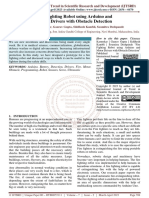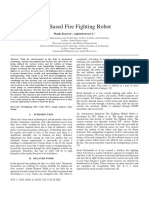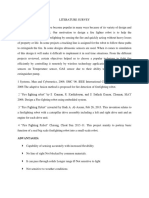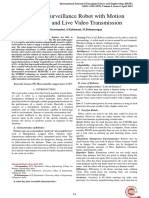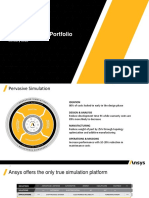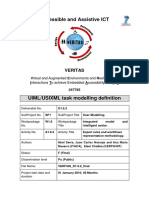Professional Documents
Culture Documents
Development and Construction of An Autonomous Firefighting Robot
Development and Construction of An Autonomous Firefighting Robot
Original Title
Copyright
Available Formats
Share this document
Did you find this document useful?
Is this content inappropriate?
Report this DocumentCopyright:
Available Formats
Development and Construction of An Autonomous Firefighting Robot
Development and Construction of An Autonomous Firefighting Robot
Copyright:
Available Formats
Volume 9, Issue 4, April – 2024 International Journal of Innovative Science and Research Technology
ISSN No:-2456-2165 https://doi.org/10.38124/ijisrt/IJISRT24APR175
Development and Construction of an Autonomous
Firefighting Robot
S.Chandrasekhar1 C.PrasanthReddy2; T.UdayKumar3; V.Vinay KumarReddy4;
Assistant Professor P. Harsha Vardhan5; V. Soma Shekhar6
Department of Mechanical Engineering, Gates Institute of UG Students
Technology Gooty Department of Mechanical Engineering, Gates Institute of
Technology Gooty
Abstract:- Mechanical technology has ended up being advanced mechanics centers around the profoundly specific,
fixing over which people groups shown their advantage. one sort of planetary wanderers. Presently, mechanical
Mechanical technology has acquired prevalence because rivalries are held occasionally both in public and global
of progression of numerous innovations of registering levels. Numerous robots intended for fire identification, fire
and nanotechnologies. So we chose to put forth human quenching. Some of them are constrained by human. So
existence more straightforward and diminish the assuming each time fire happened the robot for quenching
attempts taken by them. Our audit is to make completely the fire there is consistently a need of human to move robot
mechanized firefighting robot which manages the fire to the spot where fire happened, from this we see that the
issues in family, research centers, limited scope cycle turns out to be so extended and tedious, so there is
enterprises. This robot follows the predefined way and need to make the firefighting robot which expected to be
plays out the different assignments. We can utilize this self-controlled, likewise it have a both capacity of fire
robot to play out those assignments that might be hurtful discovery as well as fire dousing. So here we will plan AVR
and hazardous to human. The Fire sensors prepared based firefighting robot. We are utilizing Atmega16
fixed in the rooms where there will be plausible of fire is microcontroller. For mechanical movement we are utilizing
to be happened. At the point when it detects fire the DC engine driven vehicle. The primary region of our
location of area got by robot and as needs be it will reach venture is: Fire Sensor activity (IR Sensor), Microcontroller
to the objective and stifle fire right away. activity, Bluetooth activity, Robot development activity,
Sprayer activity .Block outline execution is depicted in the
Keywords:- Low-Cost Fire Fighting Robot, Wireless subsequent segment. Equipment expected for project and its
Communication, Remote Operation. subtleties are additionally depicted after it.
I. INTRODUCTION II. LITERATURE REVIEW
Firefighting robots represent a transformative U.Jyostna Sai Prasanna, M.V.D.Prasad (2013) was
advancement in emergency response technology, designed plan the fire discovery framework involving four fire
to mitigate the risks faced by firefighters and enhance their sensors in the firefighting robot, and program the fire
effectiveness in combating fires. These robots are equipped location and battling strategy utilizing sensor based
with a wide array of sensors, tools, and capabilities to technique. The firefighting robot is outfitted with four
navigate hazardous environments, detect fires, and execute thermistors/fire sensors that consistently screen the
firefighting operations autonomously or under remote temperature. In the event that the temperature increments
human supervision. With the integration of artificial past the foreordained limit esteem, signal sounds to suggest
intelligence, robotics, and sensor technologies, firefighting the event of fire mishap and an admonition message will be
robots offer a promising solution to address the challenges shipped off the separate staff in the business and to local fire
posed by complex and dangerous fire scenarios. station with the GSM module gave to it.
The word „robot‟ begins from the Czech word for Swati A. Deshmukh (2015) was completely examined
constrained work, whose imaginary automated creations was about the fire location framework involving sensors in the
similar as Dr. Frankenstein’s beast animals made by framework, and program the fire identification and battling
substance and natural, as opposed to mechanical strategies, system utilizing sensor based strategy.
presented it. Be that as it may, the ongoing mechanical
robots of mainstream society are not vastly different from Saravanan P (2015) examined about the Plan and
the imaginary organic manifestations. Frameworks that Execution of this task is mostly founded on control of Semi-
process tactile contribution to the gadgets current Independent versatile robot (SA-BOT). The framework
circumstance and train the gadget to perform activities controls four DC Equipped engines which is fueled by the
because of the circumstance in the assembling field, robot Atmega2560 and controlled independently by Route
advancement has zeroed in on designing automated arms framework which contains incorporated ultrasonic and infra-
that perform fabricating processes. In the space business, red sensors. The bot is equipped with remote camera which
IJISRT24APR175 www.ijisrt.com 145
Volume 9, Issue 4, April – 2024 International Journal of Innovative Science and Research Technology
ISSN No:-2456-2165 https://doi.org/10.38124/ijisrt/IJISRT24APR175
catches the video and sends it to the base station. The fire
location framework contains LDR and temperature sensor,
in the event that there is a fire, the sensors identifies it and
the bot will be moved to the source and starts dousing it.
The Dousing Framework includes a BLDC engine with
water holder. The SABOT can likewise be worked
physically for outrageous circumstances. We have given a
GUI support through which the bot can controlled from the
base station.
III. HARDWARE SPECIFICATIONS
Fig 4 Motor
ATmega16 microcontroller.
Bluetooth Receiver.
L293D IC.
Robot chassis.
Motors.
Buzzer.
PIR Sensor.
Fire sensor.
LPG Sensor.
Water pump.
Fig 5 Buzzer
Fig 1 ATmega16 Microcontroller
Fig 6 Robot Chassis
Fig 2 Bluetooth Receiver
Fig 7 PIR Sensor
Fig 3 L293D IC Fig 8 Fire Sensor
IJISRT24APR175 www.ijisrt.com 146
Volume 9, Issue 4, April – 2024 International Journal of Innovative Science and Research Technology
ISSN No:-2456-2165 https://doi.org/10.38124/ijisrt/IJISRT24APR175
making the firefighting robot move around effectively and
put out fires efficiently.
Robot chassis:
This is the body or frame of the robot. It holds all the
parts together and gives the robot its structure.
Servo Motors:
Make the robot move engines. They turn the wheels or
tracks so the robot can go where it needs to. A servo engine
is a sort of rotating actuator that considers exact control of
Fig 9 LPG Sensor precise position. It comprises of an engine combined with a
sensor for position input, typically a potentiometer. The
engine is constrained by sending a PWM (Heartbeat Width
Balance) signal, which decides the ideal place of the engine
shaft. Servo engines are usually utilized in different
applications where exact control of rakish position is
required, like advanced mechanics, remote-controlled
vehicles, modern mechanization, and aviation systems. They
are especially famous in specialist and instructive
undertakings because of their convenience and
moderateness.
Fig 10 Water Pump
Buzzer:
It's like the robot's voice. It makes noise to alert people
ATmega16 Microcontroller:
if there's danger, like a fire or gas leak.
The ATmega16 microcontroller as the smart brain of
the firefighting robot. It's like the robot's decision-maker and
PIR Sensor:
coordinator. This tiny chip is responsible for taking in
Think of the PIR sensor as the "fire detector" of the
information from sensors, like detecting fires or obstacles,
firefighting robot. Just like how a smoke alarm senses
and then deciding what actions the robot should take. For
smoke, the PIR sensor detects heat or movement. When
instance, when it senses a fire, it tells the motors to move the
there's a fire, the PIR sensor picks up the heat it produces
robot towards it. It's like the captain of the team, directing
and sends a signal to the robot's brain, telling it that there's a
everyone to tackle the fire and keep everyone safe. Without
fire nearby. This helps the robot know where to go and what
the ATmega16, the robot wouldn't know how to respond to
to do, like spraying water to put out the flames. So, in a
emergencies, so it's essential for making sure the firefighting
simple way, the PIR sensor acts like the robot's eyes,
robot does its job effectively.
helping it see and respond to fires quickly.
Bluetooth Receiver:
Fire Sensor:
The Bluetooth receiver for the firefighting robot as its
Think of the fire sensor as the "fire alarm" for the
ears. Just like how we use our ears to listen and follow
firefighting robot. Just like how a fire alarm detects smoke
instructions, the Bluetooth receiver allows the robot to
or heat, the fire sensor can detect the presence of fire. When
receive commands wirelessly. It's like having a remote
the sensor senses flames or excessive heat, it sends a signal
control for the robot. So, when a firefighter wants the robot
to the robot's control system, alerting it to the fire's location.
to move closer to a fire or change its direction, they can send
This helps the robot quickly locate and respond to the fire,
those commands using a smart phone or another Bluetooth-
like spraying water to extinguish the flames. So, in a simple
enabled device. The receiver then picks up those commands
way, the fire sensor acts as the robot's early warning system,
and tells the robot what to do. It's a simple but crucial part of
helping it detect fires and take action to put them out.
the robot's communication system, helping it to respond
quickly and effectively to the firefighter's instructions.
LPG Sensor:
Imagine the LPG sensor as the "smell detector" for the
L293D IC:
firefighting robot. Just like how we can smell gas leaks, the
In a firefighting robot, the L293D IC is like the control
LPG sensor can detect the presence of LPG (liquefied
center for the motors. Imagine it as the brain that tells the
petroleum gas), which is often present in fires. When the
robot's wheels or tracks how to move. With the L293D, the
sensor detects LPG in the air, it sends a signal to the robot's
robot can go forward, backward, and turn left or right,
control system, indicating that there may be a fire nearby.
making it really agile. It's like having a remote control for
This helps the robot locate the source of the fire more
the robot's movement. This IC is super important because it
quickly and effectively. So, in a simple way, the LPG sensor
lets the robot navigate through obstacles and reach the fire
acts like the robot's nose, helping it sniff out fires and
easily. So, if you think about it, the L293D is the key to
respond to them promptly.
IJISRT24APR175 www.ijisrt.com 147
Volume 9, Issue 4, April – 2024 International Journal of Innovative Science and Research Technology
ISSN No:-2456-2165 https://doi.org/10.38124/ijisrt/IJISRT24APR175
Water Pump:
The water pump is like a water gun for the robot. It helps the robot spray water to put out fires.
Diagram
Fig 10 Diagram
Software used: Navigation:
The robot navigates towards the fire using either
AVR Studio for Programming Microcontroller predefined paths or by dynamically planning its route based
DIP follow for PCB Planning on the environment. It may use sensors such as ultrasonic
Blue Control Android Application for Controlling. sensors, LIDAR (Light Detection and Ranging), or cameras
to detect obstacles and navigate around them.
IV. WORKING& EXPERIMENTATION
Extinguishment:
Robot will be controlled by android mobile phone via Upon reaching the fire, the robot employs various
Bluetooth technology. firefighting mechanisms to extinguish the flames. Common
Android mobile phone will be having a software running methods include spraying water or fire-retardant foam onto
on it. the fire using a water cannon or nozzle. The robot may also
Using this software any person can move the robot in use a fan or other mechanisms to deprive the fire of oxygen
any desired direction. and suppress it.
It will detect the fire. If there is any fire then it will Monitoring:
start the water pump. A firefighting robot typically operates While extinguishing the fire, the robot continues to
autonomously or semi-autonomously to detect, locate, and monitor the surrounding area for any signs of reignition or
extinguish fires in hazardous environments. Here's a general spreading of the fire. It may also relay real-time data and
overview of how a firefighting robot might work: video feed to human operators or a central control station for
monitoring and decision-making.
Detection:
The robot may be equipped with various sensors to Safety Features:
detect the presence of fire, such as infrared (IR) sensors, Firefighting robots are often equipped with safety
flame detectors, smoke detectors. These sensors features such as heat-resistant materials, automatic
continuously monitor the surroundings for signs of fire. shutdown mechanisms in case of malfunction or
overheating, and built-in fire suppression systems to protect
Localization: themselves from damage during firefighting operations.
Once a fire is detected, the robot uses its sensors to
determine the precise location of the fire. This information Overall, firefighting robots provide an effective and
helps the robot navigate towards the fire source. safe means of combating fires in hazardous environments
where human intervention may be difficult or dangerous.
IJISRT24APR175 www.ijisrt.com 148
Volume 9, Issue 4, April – 2024 International Journal of Innovative Science and Research Technology
ISSN No:-2456-2165 https://doi.org/10.38124/ijisrt/IJISRT24APR175
They can operate autonomously in areas such as industrial Measure key performance metrics such as response time,
facilities, warehouses, forests, and urban environments, detection accuracy, success rate in fire suppression, and
assisting firefighters and improving overall firefighting reliability.
capabilities. Document experimental procedures, observations, and
results to inform further refinements to the robot's design
Experimentation: and functionality.
Conduct experiments to evaluate the performance and Collaborate with firefighting professionals and experts to
capabilities of the firefighting robot in various fire scenarios, validate the robot's performance and gather feedback for
including: iterative improvement.
Publish research findings and contribute to the body of
Fire Detection: knowledge in the field of firefighting robotics through
Test the robot's ability to detect fires of different sizes academic papers, conference presentations, and technical
and intensities under varying environmental conditions. reports.
V. METHODOLOGY
Problem Definition and Requirements Analysis:
Characterize the goals and extent of the firefighting
robot project.
Recognize the particular necessities and difficulties the
robot needs to address, like fire recognition, route in
smoke-filled conditions, and viable fire concealment.
Research and Design Planning:
Conduct research on existing firefighting robot designs,
technologies, and best practices.
Develop a conceptual design for the firefighting robot,
considering factors such as size, mobility, sensor
Fig 11 Development and Construction of an Autonomous integration, and firefighting mechanisms.
Firefighting Robot
Component Selection and Procurement:
Navigation:
Assess the robot's navigation capabilities in smoke- Select appropriate hardware components based on the
filled environments, cluttered spaces, and uneven terrain. design requirements and budget constraints.
Procure components such as microcontrollers, sensors,
Fire Suppression: actuators, and structural materials from reliable
Evaluate the effectiveness of the robot's firefighting suppliers.
mechanisms in extinguishing fires and preventing their
spread. Prototyping and Assembly:
Build a prototype of the firefighting robot based on the
conceptual design.
Assemble the selected components onto the robot
chassis, ensuring proper wiring, mounting, and structural
integrity.
Software Development:
Develop the firmware and software algorithms required
to control the robot's behavior.
Program the microcontroller to interface with sensors,
process sensor data, make decisions, and control
actuators.
Fig 12 Development and Construction of an Autonomous
Firefighting Robot
IJISRT24APR175 www.ijisrt.com 149
Volume 9, Issue 4, April – 2024 International Journal of Innovative Science and Research Technology
ISSN No:-2456-2165 https://doi.org/10.38124/ijisrt/IJISRT24APR175
Sensor Integration and Calibration: Hazards: Navigate through industrial settings to manage
fires involving hazardous materials.
Integrate sensors such as fire sensors, temperature Search and Rescue: Assist in finding and rescuing
sensors, gas sensors, and motion sensors onto the robot. people trapped in hazardous environments during fires.
Calibrate sensors to ensure accurate and reliable Hazardous Material Handling: Transport and contain
detection of fire, heat, smoke, and other relevant dangerous substances to minimize risks to human
environmental parameters. responders.
Remote Monitoring: Patrol areas prone to fires, detect
Navigation and Localization: early signs of fires, and provide real-time data to
firefighters.
Implement algorithms for autonomous navigation and Training Simulations: Provide realistic scenarios for
obstacle avoidance. firefighter training exercises to enhance skills and
Incorporate localization techniques such as GPS, inertial preparedness.
navigation, or SLAM (Simultaneous Localization and Post-Fire Cleanup: Assist in assessing damage,
Mapping) to enable the robot to determine its position identifying hotspots, and cleaning up debris after fires.
and navigate effectively in indoor and outdoor Aerial Support: Utilize drones for aerial
environments. reconnaissance, firefighting, and delivering supplies to
firefighters on the ground.
Fire Suppression Mechanisms: Collaborative Efforts: Work alongside human
firefighters to enhance response capabilities and improve
Integrate firefighting mechanisms such as water pumps, overall firefighting outcomes.
extinguisher dispensers, or foam sprayers onto the robot.
Develop control algorithms for activating and controlling Advantages
firefighting mechanisms based on sensor inputs and
environmental conditions. Robot can stifle the fire without hurting people being.
Robot can go to hazardous spots where individual can
Testing and Evaluation: not go.
Less reason for mishap cases. In any event, Working is
Conduct rigorous testing of the firefighting robot in done programmed mode as well as manual mode.
simulated fire scenarios and real-world environments. Human prerequisite is less.
Evaluate the robot's performance in terms of fire Support cost is less.
detection accuracy, navigation efficiency, fire Effectively repairable.
suppression effectiveness, and overall reliability.
Further developed security.
Assurance of property from misfortune.
Iterative Improvement:
Basic in development.
Simple to screen.
Analyze test results and identify areas for improvement
in the robot's design, hardware, and software. Little in size.
Iteratively refine the robot's design and functionality Safety: Robots keep firefighters out of harm's way
based on feedback from testing and evaluation. 24/7 Availability: They can work round the clock
without fatigue.
Applications Remote Operation: Operated from a safe distance by
human controllers.
Smothering fire where probability of blast is more is Precision: Perform firefighting tasks accurately and
utilized efficiently.
It utilized as home security application. Data Gathering: Collect real-time information for
It is utilized in server rooms in workplaces. informed decision-making.
It is helpful in misfortune region observing and salvage. Cost-Effectiveness: Save money in the long run by
reducing property damage.
Sure, here are some Straightforward Applications of Versatility: Can be adapted for various firefighting
Firefighting Robots: tasks.
Collaboration: Work alongside human firefighters to
Indoor Fires: Enter burning buildings to locate and improve efficiency.
extinguish fires, especially in areas too dangerous for Adaptability: Operate in extreme conditions where
humans. humans may struggle.
Wildfires: Deploy in forests and remote areas to Public Confidence: Showcase commitment to safety
suppress wildfires by spraying water or fire-retardant and innovation.
substances.
IJISRT24APR175 www.ijisrt.com 150
Volume 9, Issue 4, April – 2024 International Journal of Innovative Science and Research Technology
ISSN No:-2456-2165 https://doi.org/10.38124/ijisrt/IJISRT24APR175
WinAVR
There are multiple ways that you can compose,
incorporate, and download a program to the ATmega16
microcontroller. There are a wide range of word processors,
compilers, and utilities accessible for the vast majority
various dialects (C, Essential, low level computing
construct, and so on.). A portion of these are for nothing,
and some require a permitting expense to utilize them. In
this class, we will utilize a freeware bundle of programming
devices named WinAVR (articulated, "at whatever point").
WinAVR has been introduced on the PCs in the
Mechatronics Research facility, yet you are emphatically
urged to download it and introduce it on your own PC, so
you can work with your microcontroller beyond the lab.
Guidelines for introducing WinAVR are given in Fig 13 Development and Construction of an Autonomous
Supplement A toward the finish of this report. Firefighting Robot
WinAVR comprises of a set-up of executable, open You will utilize a freeware program from Atmel called
source programming improvement devices for the Atmel AVR Studio to sort out every one of the records expected to
AVR series of RISC chip facilitated on the Windows stage. gather a program to run on the microcontroller. The
following couple of steps will lead you through the most
It incorporates the GNU GCC compiler for C and C++,
which is at times alluded to as avr-gcc. Customarily, the common way of setting up a document structure, which will
contain the required files. Note that the PCs in the
microcontroller in implanted frameworks was modified
Mechatronics lab as of now have AVR Studio and WinAVR
straightforwardly utilizing low level computing construct.
Low level computing construct utilizes just the essential introduced on them. To deal with a microcontroller outside
guidance set for a specific microcontroller. While this can the lab, you should introduce this product on your own PC.
deliver quick, effective code, it is restricted in that each See Reference section A toward the finish of this record for
processor type has its own guidance set. In this manner it's directions.
anything but a down to earth language to learn except if you
are doing an undertaking that is committed to a particular Open AVR Studio by double tapping its symbol on
microcontroller or has a genuine requirement for exact your work area or choosing it in the Beginning Menu. Select
timing as well as memory use. The C language, then again, Undertaking - > New Venture starting from the drop menus
or New Task from the spring up window if one opens when
is ordinarily utilized in industry and can be applied over
you send off AVR Studio. You ought to consider the new
various stages. By realizing this one language, you will
task window to be displayed in Figure.
actually want to program practically any microcontroller,
given that you have a compiler that can make an
interpretation of C code into low level computing construct
for your regulator. The Gnu-C compiler is an open-source,
freeware, C compiler that frames the reason for compilers
that produce code for the vast majority different
microcontrollers and different working frameworks, like
Windows and UNIX.
Procedure
Presently, you'll start constructing your most
memorable venture. For this first undertaking, you will
utilize a model program accommodated you that shows how
to print messages to the sequential port. Attempt to recollect
these means, since you should go through them in resulting
labs. The more comfortable you are with these means, the
quicker the labs will go from here on out.
Fig 14 AVR Studio New Under Taking Window
IJISRT24APR175 www.ijisrt.com 151
Volume 9, Issue 4, April – 2024 International Journal of Innovative Science and Research Technology
ISSN No:-2456-2165 https://doi.org/10.38124/ijisrt/IJISRT24APR175
Note the Settings Utilized for this Lab and where your incorporate the area of where their registries dwell. In the
Envelope will be Made. In the New Undertaking Spring model above, AVRlib was likewise included. You needn't
up Window: bother with AVR lib for this lab.
Select AVR GCC and type an illustrative name into the
Task name field (like (FirstAVRproject).Since you will VI. CONCLUSION
utilize gave source codes uncheck the Make beginning
record box. Check the Make envelope box. Peruse to Fire causes enormous harm and loss of human
guarantee that the Place (where your undertaking will be existence and property. In this paper we have planned a
saved) as of now exists, so you know about where you are putting out fires robot which to be controlled utilizing
saving documents. Make certain to ultimately duplicate your microcontroller ARDUINO Uno. Result of the sensors is
task documents onto a USB drive or email your source given to microcontroller board and likewise robot is worked
records to yourself, on the grounds that any documents left effectively.
on the lab PCs might be changed or erased out of the blue.
REFERENCES
Click the Following >> button
Select AVR Test system in the Troubleshoot stage field. [1]. Kristi Kosasih, E. Merry Sartika, M. Jimmy
Select ATmega16 (not ATmega16A) in the Gadget Hasugian, danMuliady, “The Intelligent Fire Fighting
field.(scroll down, it is there) Tank Robot”, Electrical Engineering Journal Vol. 1,
Click the Completion button No. 1, October 2010.
Arrange your task settings utilizing the Venture - > [2]. B. L. Theraja, A. K. Theraja, “A textbook of
Design Choices drop down menu as displayed in Figure. Electrical Technology” Volume 2.
Change the Recurrence box to 8000000.(8 million [3]. Ashfaq Hussain, “Electric Machines”.
without the commas. Note that assuming you get a [4]. E. Krasnov and D. Bagaev, "Conceptual analysis of
blunder with respect to F_CPU indistinct, it is on the firefighting robots' control systems", 2012 IV
grounds that you failed to remember this step.) International Conference “Problems of Cybernetics
and Informatics” (PCI), pp. 1-3, 2012
Change the Enhancement box to - O2.
[5]. T. L. Chien, H. Guo, K. L. Su and S. V. Shiau,
Click on the Incorporate Catalogs button viewed as on
"Develop a Multiple Interface Based Fire Fighting
the left side.
Robot", 2007 IEEE International Conference on
Click on the New Envelope symbol (upper right corner) Mechatronics, pp. 1-6, 2007.
and utilize the peruse circle "… " to add your task [6]. H. Amano, "Present status and problems of
organizer you made in Sync #3 (shows up as .\ )Snap firefighting robots", Proceedings of the 41st SICE
alright
Annual Conference. SICE 2002, vol. 2, pp. 880-885,
2002.
[7]. K. L. Su, "Automatic Fire Detection System Using
Adaptive Fusion Algorithm for Fire Fighting Robot",
2006 IEEE International Conference on Systems, pp.
966-971, 2006.
Fig 15 Project Design Choices
Any time you make a task utilizing AVR Studio, you
ought to set the Recurrence and Enhancement as displayed
above to one side. You likewise need to incorporate the
registry that you have your source code in (denoted.\) by
going to the Incorporate Catalogs choice, adding it as
another envelope, and perusing to where it is on the PC as
displayed above to one side. Assuming you use code from
some other undertaking catalog or library, you should
IJISRT24APR175 www.ijisrt.com 152
You might also like
- 06 - Multiple-Poin Simulation (MPS)Document22 pages06 - Multiple-Poin Simulation (MPS)Mustapha BouregaaNo ratings yet
- CBC Organic Vegetable Production Leading To Organic Agriculture Production NC IIDocument53 pagesCBC Organic Vegetable Production Leading To Organic Agriculture Production NC IIJapet J100% (2)
- Animation NC IIDocument44 pagesAnimation NC IIRyan Songcuya100% (2)
- Machine Learning in Engineering Applications and TrendsDocument27 pagesMachine Learning in Engineering Applications and Trends김형진100% (1)
- Electrical Power System Model On MATLAB SimulinkDocument2 pagesElectrical Power System Model On MATLAB Simulinkaalamz93_854917254No ratings yet
- Yellow Pages GeothermalDocument29 pagesYellow Pages GeothermalHarry EP Situmorang100% (1)
- Bridge Team ManagementDocument2 pagesBridge Team ManagementArtur MouraNo ratings yet
- Fire Extinguisher RobotDocument23 pagesFire Extinguisher RobotIJRASETPublicationsNo ratings yet
- Remote Controlled Fire Fighting RobotDocument7 pagesRemote Controlled Fire Fighting RobotEditor IJTSRDNo ratings yet
- Swarm Intelligence Based Fire Fighting RobotDocument6 pagesSwarm Intelligence Based Fire Fighting RobotIJAERS JOURNALNo ratings yet
- Ijetae 1214 100Document5 pagesIjetae 1214 100akula pranathiNo ratings yet
- FFR TdayDocument31 pagesFFR TdaySyed MohiuddinNo ratings yet
- Fire Extinguishing RobotDocument4 pagesFire Extinguishing RobotShree Krishna TaraiNo ratings yet
- Design and Fabrication of Automated Fire Fighting RobotDocument9 pagesDesign and Fabrication of Automated Fire Fighting RobotIJRASETPublicationsNo ratings yet
- IOT Based Human Search and Rescue Robot Using Swarm RoboticsDocument6 pagesIOT Based Human Search and Rescue Robot Using Swarm RoboticsMayuresh SarodeNo ratings yet
- Monitoring and Controlling of Fire Fighthing Robot Using IOTDocument6 pagesMonitoring and Controlling of Fire Fighthing Robot Using IOT21146387No ratings yet
- Warfare RobotDocument3 pagesWarfare RobotEditor IJTSRDNo ratings yet
- Fin Irjmets1684126285Document10 pagesFin Irjmets1684126285arafarhossain45No ratings yet
- Fire Fighting Robot With ArtificialDocument7 pagesFire Fighting Robot With ArtificialLumisense TechnologiesNo ratings yet
- Ecs Final Report-FasttrackDocument14 pagesEcs Final Report-Fasttrackpranay kumarNo ratings yet
- Mr. FFRRDocument24 pagesMr. FFRRSyed MohiuddinNo ratings yet
- Fire Fighting Robot Using Arduino and Motor Drivers With Obstacle DetectionDocument3 pagesFire Fighting Robot Using Arduino and Motor Drivers With Obstacle DetectionEditor IJTSRDNo ratings yet
- Fire Fighting Robot Using Arduino and Motor Drivers With Obstacle DetectionDocument3 pagesFire Fighting Robot Using Arduino and Motor Drivers With Obstacle DetectionEditor IJTSRDNo ratings yet
- Review Paper On Arduino Based Fire Fighting RobotDocument8 pagesReview Paper On Arduino Based Fire Fighting RobotIJRASETPublicationsNo ratings yet
- IoT Based Smart Multi Application SurveillanceDocument5 pagesIoT Based Smart Multi Application SurveillanceVundi Sri Harsha100% (1)
- Gesture Control of Robotic Arm: Institute of Research AdvancesDocument9 pagesGesture Control of Robotic Arm: Institute of Research AdvancesaarthiNo ratings yet
- Design and Analysis The Fire Fighting RobotDocument6 pagesDesign and Analysis The Fire Fighting RobotGopi ChandNo ratings yet
- DrawingRobotusingFirebirdV PDFDocument5 pagesDrawingRobotusingFirebirdV PDFBikram ChowdhuryNo ratings yet
- IOT Based Fire Fighting Robot: Megha Kanwar, Agilandeeswari LDocument6 pagesIOT Based Fire Fighting Robot: Megha Kanwar, Agilandeeswari Lpooja madhurkarNo ratings yet
- P256 264 PDFDocument9 pagesP256 264 PDFAamir Majeed BhatNo ratings yet
- Project - Fire Detection and Extinguishing RobotDocument16 pagesProject - Fire Detection and Extinguishing RobotRakesh SNo ratings yet
- Literature SurveyDocument3 pagesLiterature SurveydileeppatraNo ratings yet
- Live Human Detecting Robot For Earthquak PDFDocument3 pagesLive Human Detecting Robot For Earthquak PDFsiddharthNo ratings yet
- IJCRT1892114Document4 pagesIJCRT1892114rassNo ratings yet
- Review Paper On Arduino Based Fire Fighting Robot-with-cover-page-V2Document9 pagesReview Paper On Arduino Based Fire Fighting Robot-with-cover-page-V2Tiffany DagatanNo ratings yet
- Android Military Spying and Bomb Disposal RobotDocument7 pagesAndroid Military Spying and Bomb Disposal Robot1DA14EC106 R. LALHRIATPUIANo ratings yet
- Design and Implementation of Gesture Controlled Robotic Arm For Industrial Applications1Document9 pagesDesign and Implementation of Gesture Controlled Robotic Arm For Industrial Applications1Akhilesh YadavNo ratings yet
- Chapter 1 RoboticsDocument36 pagesChapter 1 RoboticsZishan TariqNo ratings yet
- Wireless Surveillance Robot With Motion Detection and Live Video TransmissionDocument9 pagesWireless Surveillance Robot With Motion Detection and Live Video TransmissionrajatpreetNo ratings yet
- Proposal of Robot ThesisDocument5 pagesProposal of Robot ThesisHus Forth CorrentyNo ratings yet
- Iot Based Hand Gesture Controlled Robotic ArmDocument13 pagesIot Based Hand Gesture Controlled Robotic ArmVivek RahangdaleNo ratings yet
- Fire Fighting Robot With AIDocument21 pagesFire Fighting Robot With AINayomikareddyNo ratings yet
- Fire Fighting RobotDocument6 pagesFire Fighting RobotIJRASETPublicationsNo ratings yet
- Micro RobotDocument5 pagesMicro RobotIJRASETPublicationsNo ratings yet
- Embedded Based Fire Detection and Fighting Robot Using IoT For Industrial EnvironmentDocument4 pagesEmbedded Based Fire Detection and Fighting Robot Using IoT For Industrial Environmentgn45591No ratings yet
- Design and Implementation of Application Software For User Friendly Operation of Industrial RobotDocument5 pagesDesign and Implementation of Application Software For User Friendly Operation of Industrial RobotIIR indiaNo ratings yet
- Multitasking Military Spying RobotDocument5 pagesMultitasking Military Spying RobotIJARSCT JournalNo ratings yet
- VR Based Tele-Presence Robot Using Raspberry PiDocument6 pagesVR Based Tele-Presence Robot Using Raspberry PiIJRASETPublicationsNo ratings yet
- Developing and Using An IOT-Powered Adaptive Device For The MilitaryDocument4 pagesDeveloping and Using An IOT-Powered Adaptive Device For The MilitaryInternational Journal of Innovative Science and Research TechnologyNo ratings yet
- Alive Human Body Detection and Tracking System Using An Autonomous PC Controlled Rescue RobotDocument4 pagesAlive Human Body Detection and Tracking System Using An Autonomous PC Controlled Rescue RobotrajatpreetNo ratings yet
- Design and Implementation of A Wireless Gesture Controlled Robotic Arm With VisionDocument8 pagesDesign and Implementation of A Wireless Gesture Controlled Robotic Arm With VisionAli Najim Al-AskariNo ratings yet
- Review Paper On Gesture Controlled Robotic Arm Using IoTDocument2 pagesReview Paper On Gesture Controlled Robotic Arm Using IoTInternational Journal of Innovative Science and Research TechnologyNo ratings yet
- 44 FireDocument7 pages44 FirechirandasprabhakarNo ratings yet
- Design and Fabrication of An Autonomous Fire Fighting Robot With Multisensor Fire Detection Using PID ControllerDocument7 pagesDesign and Fabrication of An Autonomous Fire Fighting Robot With Multisensor Fire Detection Using PID ControllerAbdul RazzakNo ratings yet
- Design of IoT Robot For Military Applications IoT Applications in Defense & SecurityDocument7 pagesDesign of IoT Robot For Military Applications IoT Applications in Defense & SecurityInternational Journal of Innovative Science and Research TechnologyNo ratings yet
- Wireless Bomb Defusing Robot With Camera InterfacingDocument4 pagesWireless Bomb Defusing Robot With Camera InterfacingijsretNo ratings yet
- A Custom Designed 3D Printed 4 DoF Mobile Robotic Arm For Remote ExplorationDocument6 pagesA Custom Designed 3D Printed 4 DoF Mobile Robotic Arm For Remote ExplorationEditor IJTSRDNo ratings yet
- Human Detection Robot (ROHSAR) : September 2016Document17 pagesHuman Detection Robot (ROHSAR) : September 2016Vinay BhogalNo ratings yet
- Design and Analysis of Mini Fire Fighting RobotDocument7 pagesDesign and Analysis of Mini Fire Fighting RobotIJRASETPublicationsNo ratings yet
- Robotic Arm For SurveillanceDocument47 pagesRobotic Arm For SurveillanceRudresh RakeshNo ratings yet
- 13 Ijmtst0807037Document4 pages13 Ijmtst0807037aryanNo ratings yet
- Iot Based Camouflage Army Robot: ArticleDocument7 pagesIot Based Camouflage Army Robot: ArticleRakesh JainNo ratings yet
- Obstacle Avoidance Robot Using Arduino IJERTCONV6IS13197Document4 pagesObstacle Avoidance Robot Using Arduino IJERTCONV6IS13197Xaf FarNo ratings yet
- CSE JournalsDocument12 pagesCSE Journalsgraphic designerNo ratings yet
- SR 21705175854Document5 pagesSR 21705175854Brendon GovereNo ratings yet
- Robot Operating System (ROS): The Complete Reference (Volume 6)From EverandRobot Operating System (ROS): The Complete Reference (Volume 6)No ratings yet
- The Impact of Store Atmosphere and Customer Experience on Consumer Purchasing Decisions of KFC Wahidin GresikDocument5 pagesThe Impact of Store Atmosphere and Customer Experience on Consumer Purchasing Decisions of KFC Wahidin GresikInternational Journal of Innovative Science and Research TechnologyNo ratings yet
- An Appraisal of Employable Content of the National Diploma in Architectural Technology Program in North East NigeriaDocument5 pagesAn Appraisal of Employable Content of the National Diploma in Architectural Technology Program in North East NigeriaInternational Journal of Innovative Science and Research TechnologyNo ratings yet
- Study of prevalence of Head Lice (Pediculus Humanus Capitis) Among Schoolchildren in the Zawiya Region, LibyaDocument10 pagesStudy of prevalence of Head Lice (Pediculus Humanus Capitis) Among Schoolchildren in the Zawiya Region, LibyaInternational Journal of Innovative Science and Research Technology0% (1)
- The Impact of the Commercial Agriculture Credit Scheme (CACS) on the Agricultural Economy of Nigeria and its Total Output (2015-2019)Document8 pagesThe Impact of the Commercial Agriculture Credit Scheme (CACS) on the Agricultural Economy of Nigeria and its Total Output (2015-2019)International Journal of Innovative Science and Research TechnologyNo ratings yet
- Thickness CipherDocument3 pagesThickness CipherInternational Journal of Innovative Science and Research TechnologyNo ratings yet
- Human Resource Functions: Examining Insights from ABC Research OrganizationDocument9 pagesHuman Resource Functions: Examining Insights from ABC Research OrganizationInternational Journal of Innovative Science and Research TechnologyNo ratings yet
- Conceptualized Fusion Reactor based on Gas Turbine with High Temperature CO2Document7 pagesConceptualized Fusion Reactor based on Gas Turbine with High Temperature CO2International Journal of Innovative Science and Research TechnologyNo ratings yet
- The Expanding Attack Surface: Securing AI and Machine Learning Systems in Security OperationsDocument8 pagesThe Expanding Attack Surface: Securing AI and Machine Learning Systems in Security OperationsInternational Journal of Innovative Science and Research Technology100% (1)
- Integrating Quantum Algorithms with Gravitational-Wave Metrology for Enhanced Signal DetectionDocument18 pagesIntegrating Quantum Algorithms with Gravitational-Wave Metrology for Enhanced Signal DetectionInternational Journal of Innovative Science and Research Technology100% (1)
- Teacher-Induced Academic Stress: Predicting Eating Behavior Problems in College StudentsDocument8 pagesTeacher-Induced Academic Stress: Predicting Eating Behavior Problems in College StudentsInternational Journal of Innovative Science and Research TechnologyNo ratings yet
- The Impact of Termite Activity on the Availability of Soil Micronutrients in Tropical RegionsDocument6 pagesThe Impact of Termite Activity on the Availability of Soil Micronutrients in Tropical RegionsInternational Journal of Innovative Science and Research Technology100% (1)
- Modern Approaches to Sustainable AgricultureDocument10 pagesModern Approaches to Sustainable AgricultureInternational Journal of Innovative Science and Research Technology100% (1)
- Utilizing Chicken Eggshells and Waste Glass Powder as Cement Fillers for Environmental StabilityDocument6 pagesUtilizing Chicken Eggshells and Waste Glass Powder as Cement Fillers for Environmental StabilityInternational Journal of Innovative Science and Research TechnologyNo ratings yet
- Assessment of Integrated Poultry Manure and Synthetic Fertilizer Effects on Maize (Zea mays) Growth and Soil Properties: A Study from Bayero University, KanoDocument15 pagesAssessment of Integrated Poultry Manure and Synthetic Fertilizer Effects on Maize (Zea mays) Growth and Soil Properties: A Study from Bayero University, KanoInternational Journal of Innovative Science and Research Technology100% (1)
- Unlocking Sentiments: Enhancing IOCL Petrol Pump ExperiencesDocument8 pagesUnlocking Sentiments: Enhancing IOCL Petrol Pump ExperiencesInternational Journal of Innovative Science and Research TechnologyNo ratings yet
- Personal Capabilities of The Non-Teaching Personnel and Client SatisfactionDocument8 pagesPersonal Capabilities of The Non-Teaching Personnel and Client SatisfactionInternational Journal of Innovative Science and Research TechnologyNo ratings yet
- Transforming Challenges to Victories: An Inquiry on Transformational Leadership of School Leaders in the Public Elementary SchoolsDocument54 pagesTransforming Challenges to Victories: An Inquiry on Transformational Leadership of School Leaders in the Public Elementary SchoolsInternational Journal of Innovative Science and Research TechnologyNo ratings yet
- The Influence of Continuance Commitment on Job Satisfaction of Barangay Health Workers in Malaybalay City, BukidnonDocument14 pagesThe Influence of Continuance Commitment on Job Satisfaction of Barangay Health Workers in Malaybalay City, BukidnonInternational Journal of Innovative Science and Research TechnologyNo ratings yet
- Intelligent Clinical Documentation: Harnessing Generative AI For Patient-Centric Clinical Note GenerationDocument15 pagesIntelligent Clinical Documentation: Harnessing Generative AI For Patient-Centric Clinical Note GenerationInternational Journal of Innovative Science and Research TechnologyNo ratings yet
- Solar Based Multilevel Inverter F o R BLDC Motor DriveDocument8 pagesSolar Based Multilevel Inverter F o R BLDC Motor DriveInternational Journal of Innovative Science and Research TechnologyNo ratings yet
- Design and Development of Multi-Featured Medical StretcherDocument4 pagesDesign and Development of Multi-Featured Medical StretcherInternational Journal of Innovative Science and Research TechnologyNo ratings yet
- Meta Land: Redefining Virtual Communities Through Centralized Governance, Inclusivity and InnovationDocument5 pagesMeta Land: Redefining Virtual Communities Through Centralized Governance, Inclusivity and InnovationInternational Journal of Innovative Science and Research TechnologyNo ratings yet
- Exploring The Potential Advantages of Traditional Therapies in Autoimmune Blistering Illnesses: A Comprehensive Review and Analysis, ResearchDocument12 pagesExploring The Potential Advantages of Traditional Therapies in Autoimmune Blistering Illnesses: A Comprehensive Review and Analysis, ResearchInternational Journal of Innovative Science and Research TechnologyNo ratings yet
- Strategic Deployment of Ducklink Wireless Devices For Disaster Mitigation and Management in Nueva ECIJA University of Science and Technology Sumacab CampusDocument13 pagesStrategic Deployment of Ducklink Wireless Devices For Disaster Mitigation and Management in Nueva ECIJA University of Science and Technology Sumacab CampusInternational Journal of Innovative Science and Research TechnologyNo ratings yet
- Seasonal Variation and Distribution Patterns of Endophytic Community in Withania SomniferaDocument7 pagesSeasonal Variation and Distribution Patterns of Endophytic Community in Withania SomniferaInternational Journal of Innovative Science and Research TechnologyNo ratings yet
- Skin Disease Detection and Remedial SystemDocument7 pagesSkin Disease Detection and Remedial SystemInternational Journal of Innovative Science and Research TechnologyNo ratings yet
- EmoConnect: Nurturing Trust and Relationship Bonds in Alzheimer's ConversationsDocument3 pagesEmoConnect: Nurturing Trust and Relationship Bonds in Alzheimer's ConversationsInternational Journal of Innovative Science and Research TechnologyNo ratings yet
- Development of Smart Ground Fault Location Model For Radial Distribution SystemDocument14 pagesDevelopment of Smart Ground Fault Location Model For Radial Distribution SystemInternational Journal of Innovative Science and Research TechnologyNo ratings yet
- Smart and Secure Home With ChatbotDocument9 pagesSmart and Secure Home With ChatbotInternational Journal of Innovative Science and Research TechnologyNo ratings yet
- Preparation and Identification of Magnetic Iron Nanoparticle Based On A Natural Hydrogel and Its Performance in Targeted Drug DeliveryDocument17 pagesPreparation and Identification of Magnetic Iron Nanoparticle Based On A Natural Hydrogel and Its Performance in Targeted Drug DeliveryInternational Journal of Innovative Science and Research TechnologyNo ratings yet
- Design of Mechatronics System QBDocument14 pagesDesign of Mechatronics System QBChandni DayakarNo ratings yet
- Designing Lightweight Diesel Engine Alternator Support Bracket With Topology Optimization MethodologyDocument21 pagesDesigning Lightweight Diesel Engine Alternator Support Bracket With Topology Optimization MethodologyAhmad AmeerNo ratings yet
- Introducere Arena Visual DesignerDocument61 pagesIntroducere Arena Visual Designercosti cochet100% (1)
- Mba Unit 2 and Unit 3Document23 pagesMba Unit 2 and Unit 3FarhaNo ratings yet
- 2007, JP PDFDocument21 pages2007, JP PDFJATINNo ratings yet
- Allain CST101 Spring 2023Document3 pagesAllain CST101 Spring 2023Cesar AllainNo ratings yet
- Instruction Open Ended LabDocument3 pagesInstruction Open Ended Lablogen boyNo ratings yet
- Cassette & IP Maintenance Guide - EN - 120326Document8 pagesCassette & IP Maintenance Guide - EN - 120326salguerotiNo ratings yet
- 2022 R1 Ansys Product Portfolio - Customer PresentationDocument24 pages2022 R1 Ansys Product Portfolio - Customer PresentationSamuel ThomasNo ratings yet
- 01 - Testing P&C Systems - Consid. & RequirementsDocument24 pages01 - Testing P&C Systems - Consid. & RequirementsHassan TahaNo ratings yet
- An Effective Threat Evaluation Algorithm For Multiple Ground Targets in Multi-Target and Multi-Weapon EnvironmentsDocument7 pagesAn Effective Threat Evaluation Algorithm For Multiple Ground Targets in Multi-Target and Multi-Weapon EnvironmentsTrường Nguyễn XuânNo ratings yet
- Finite Element Simulation of Conventional and High Speed Machining of Ti6Al4V AlloyDocument9 pagesFinite Element Simulation of Conventional and High Speed Machining of Ti6Al4V AlloyArul KirubakaranNo ratings yet
- Simple Exercises in Matlab/Simulink IIDocument8 pagesSimple Exercises in Matlab/Simulink IIGarunendra BunkarNo ratings yet
- Inbound Supply Chain Modeling in Sugar IndustryDocument10 pagesInbound Supply Chain Modeling in Sugar Industryrsdeshmukh0% (1)
- PopulationDynamics StudentWS CL - 0Document7 pagesPopulationDynamics StudentWS CL - 0Daniel RiañoNo ratings yet
- KTM Case StudyDocument2 pagesKTM Case StudyThiago FloresNo ratings yet
- VERITAS D1.6.2 Final LastDocument55 pagesVERITAS D1.6.2 Final LastgkoutNo ratings yet
- Lesson-1 Modeling and SimulationDocument24 pagesLesson-1 Modeling and SimulationSundaramali Govindaswamy GNo ratings yet
- Rle Rotation 5 Simulated Clinical ExperienceDocument5 pagesRle Rotation 5 Simulated Clinical ExperienceKatherine VerceluzNo ratings yet
- Spe 115744 MS PDocument11 pagesSpe 115744 MS PBouzid AbdouNo ratings yet
- Bentley Watercad Brosura PDFDocument2 pagesBentley Watercad Brosura PDFNeng RohmaNo ratings yet
- Practical Microsimulation Modelling Practical Econometrics Odonoghue All ChapterDocument67 pagesPractical Microsimulation Modelling Practical Econometrics Odonoghue All Chapterpaul.wells767100% (8)
- TECHNICAL CATALOGUE - H - IEC - STD - EN - Rev0 - 2020 PDFDocument296 pagesTECHNICAL CATALOGUE - H - IEC - STD - EN - Rev0 - 2020 PDFAndresMarcanoNo ratings yet























